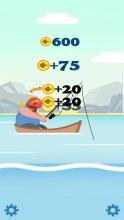Content:
Fishing under the banana tree is a serene and unique experience that combines the tranquility of nature with the thrill of catching fish. Whether you are a seasoned angler or a beginner looking to try something new, mastering the art of fishing under the banana tree can be both rewarding and enjoyable. Here are some essential tips and techniques to help you get started.
Choosing the Right Spot
The first step in fishing under a banana tree is to find the perfect spot. Look for a tree with a wide, sturdy trunk and a dense canopy. The roots of the banana tree provide excellent cover for fish, making it an ideal spot for fishing. Additionally, ensure that the area around the tree is clear of debris and that you have enough space to cast your line comfortably.
Understanding the Habitat
Banana trees thrive in tropical and subtropical regions, which means that the fish you're likely to encounter will be adapted to warm water conditions. These fish often include species like tilapia, catfish, and various species of minnows. Understanding the habits of these fish is crucial for successful fishing.
Timing is Everything
The best time to fish under a banana tree is during the early morning or late afternoon when the sun is not as intense. These times provide cooler water temperatures, which are more comfortable for both the fish and the angler. Additionally, fish are often more active during these periods, making it easier to catch them.
Selecting the Right Equipment
For fishing under a banana tree, you'll need the following equipment:
- Rod and Reel: A lightweight spinning rod with a moderate action is ideal for casting in tight spaces.
- Line: Use a monofilament line with a thickness that matches the size of the fish you're targeting. A line thickness between 6 to 12 pounds is generally suitable.
- Hooks: Choose hooks that are appropriate for the size of the bait you plan to use. For small fish, a size 6 to 10 hook is sufficient.
- Bait: Live bait, such as worms or crickets, can be highly effective. Artificial lures like small jigs or spinners can also work well.
- Tackle Box: Carry a tackle box with essential tools like pliers, a knife, and extra hooks and line.
Casting Techniques
Casting under a banana tree requires precision to avoid snagging the foliage. Here are some casting techniques to help you out:
- Short Casts: Aim for short, controlled casts. This will help you avoid overcasting and getting tangled in the leaves.
- Toss the Line: Instead of throwing the line with force, gently toss it overhand. This will reduce the chances of the line hitting the tree.
- Practice: If you're new to fishing under a banana tree, practice your casting in an open area before heading to your spot.
Baiting and Luring Techniques
When fishing under a banana tree, the key is to present your bait or lure in a way that mimics the natural movement of the fish's prey. Here are some techniques to consider:
- Still Bait: If you're using live bait, let it sit on the bottom or hover slightly above it. The natural movement of the bait will attract fish.
- Twitching Lures: If you're using artificial lures, give them a slight twitch to mimic the action of a struggling prey.
- Vertical Jigging: For deeper water, vertical jigging can be effective. Drop your lure to the desired depth and pull it up and down in a steady rhythm.
Reading the Water
To be successful at fishing under a banana tree, you need to be observant. Look for signs of fish activity, such as bubbles, ripples, or shadows. Pay attention to the water's flow and current, as these can indicate the presence of fish.
Safety First

Always prioritize safety when fishing under a banana tree. Wear a hat and sunscreen to protect yourself from the sun, and be mindful of your surroundings. If you're fishing in a remote area, let someone know your location and expected return time.
In conclusion, fishing under the banana tree can be a rewarding and peaceful experience with the right approach. By choosing the right spot, understanding the habitat, using the appropriate equipment, and employing effective techniques, you'll be well on your way to catching fish in this unique environment. Happy fishing!












